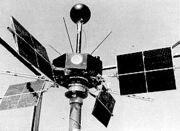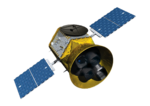Explorer 18
Topic: Astronomy
 From HandWiki - Reading time: 2 min
From HandWiki - Reading time: 2 min
 | |||||||||||||||||
| Mission type | Space physics | ||||||||||||||||
|---|---|---|---|---|---|---|---|---|---|---|---|---|---|---|---|---|---|
| Operator | NASA | ||||||||||||||||
| COSPAR ID | 1963-046A[1] | ||||||||||||||||
| SATCAT no. | 693 | ||||||||||||||||
| Spacecraft properties | |||||||||||||||||
| Manufacturer | GSFC | ||||||||||||||||
| Launch mass | 138 kg (304 lb) | ||||||||||||||||
| Start of mission | |||||||||||||||||
| Launch date | 27 November 1963, 02:24 UTC[2] | ||||||||||||||||
| Rocket | Delta C | ||||||||||||||||
| Launch site | Cape Canaveral Air Force Station LC-17B | ||||||||||||||||
| End of mission | |||||||||||||||||
| Decay date | December 30, 1965 | ||||||||||||||||
| Orbital parameters | |||||||||||||||||
| Reference system | Geocentric | ||||||||||||||||
| Regime | Highly Elliptical | ||||||||||||||||
| Eccentricity | 0.89694[1] | ||||||||||||||||
| Perigee altitude | 4,395 km (2,731 mi)[1] | ||||||||||||||||
| Apogee altitude | 192,003 km (119,305 mi)[1] | ||||||||||||||||
| Inclination | 35.2°[1] | ||||||||||||||||
| Period | 5,606 minutes[1] | ||||||||||||||||
| Epoch | 26 November 1963[1] | ||||||||||||||||
| Instruments | |||||||||||||||||
| |||||||||||||||||
Explorers | |||||||||||||||||
Explorer 18, also called IMP-A, IMP 1 and S-74, was an United States satellite launched as part of the Explorers program. Explorer 18 was launched on 27 November 1963 from Cape Canaveral, Florida, United States , with a Delta rocket. Explorer 18 was the first satellite of the Interplanetary Monitoring Platform.
Mission
Explorer 18 was a solar cell and chemical-battery powered spacecraft instrumented for interplanetary and distant magnetospheric studies of energetic particles, cosmic rays, magnetic fields, and plasmas. Initial spacecraft parameters included a local time of apogee of 1020 hours, a spin rate of 22 rpm, and a spin direction of 115° right ascension and -25° declination. Each normal telemetry sequence of 81.9 s duration consisted of 795 data bits. After every third normal sequence there was an 81.9-s interval of rubidium vapor magnetometer analog data transmission. The spacecraft performed normally until May 30, 1964, then intermittently until May 10, 1965, when it was abandoned.
The principal periods of data coverage were November 27, 1963 to May 30, 1964; September 17, 1964 to January 7, 1965; and February 21, 1965 to March 25, 1965; however, only the first of these periods was very useful.[1]
References
- ↑ 1.0 1.1 1.2 1.3 1.4 1.5 1.6 1.7 "IMP-A". NSSDC Master Catalog. NASA Goddard Space Flight Center. https://nssdc.gsfc.nasa.gov/nmc/spacecraft/display.action?id=1963-046A.
 This article incorporates text from this source, which is in the public domain.
This article incorporates text from this source, which is in the public domain.
- ↑ "Jonathan's Space Page". http://www.planet4589.org/space/log/launchlog.txt.
pl:Explorer 16
 KSF
KSF
